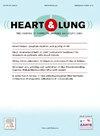A prospective randomized comparison of a pulse-contour analysis monitor versus a non-invasive bioreactance monitor in a stroke-volume based goal-directed fluid resuscitation protocol in brain-dead organ donors
IF 2.6
4区 医学
Q2 CARDIAC & CARDIOVASCULAR SYSTEMS
引用次数: 0
Abstract
Background
Brain-dead (BD) organ donors are frequently hypotensive and hypovolemic requiring fluid resuscitation. We previously published our four-hour stoke volume (SV)-based fluid resuscitation protocol that expeditiously corrected the fluid deficit and significantly decreased time on vasopressors. The SV was measured by pulse-contour analysis (PCA).
Objective
To determine if the measurement of stroke volume by bioreactance (BR) was equivalent to PCA in a goal-directed fluid resuscitation protocol in BD donors.
Methods
We performed a prospective randomized trial of fluid resuscitation in BD donors comparing the two monitors.
Results
In 169 deceased donors there were 1481 comparative measurements of SV. The correlation coefficient was 0.32. A Bland Altman analysis revealed a minimal bias (-1.8 ml) but large limits of agreement (±62.9 ml) and a percentage error of 80.5 %. A 10 % SV increase with a 500 ml fluid bolus had conflicting results between the monitors in 31.3 % of 1309 measurements. As a reference standard, the Fick method of measuring SV was used 49 times with simultaneous measurements of PCA-SV and BR-SV. The mean Fick SV (96.0 ± 30.6 ml) was significantly greater than BR (79.4 ± 18.1 ml; p<.01) and the PCA (77.2 ± 22.5 ml; p<.01). The mean SV differences for Fick-BR (16.6 ± 27.2, 95 % CI 8.78–24.42) and Fick-PCA (18.7 ± 29.0, 95 % CI 10.42–27.08) were not significantly different (p=.57).
Conclusion
Although this study demonstrated inaccuracies, imprecision, and disagreement between BR and PCA SV measurements, there was equipoise in clinical outcomes when used with our fluid resuscitation protocol, as previously published.
在脑死亡器官供者基于脑卒中容量的定向液体复苏方案中,脉冲轮廓分析监测仪与无创生物阻抗监测仪的前瞻性随机比较
脑死亡(BD)器官供者经常低血压和低血容量需要液体复苏。我们之前发表了基于4小时脑容量(SV)的液体复苏方案,该方案迅速纠正了液体不足,并显着减少了血管加压药物的使用时间。采用脉冲轮廓分析(PCA)测量SV。目的确定生物抗阻(BR)测量脑卒中容量是否等同于目标导向液体复苏方案中的PCA。方法我们对BD供者进行液体复苏的前瞻性随机试验,比较两种监测仪。结果169例死亡献血者有1481例SV比较测定。相关系数为0.32。Bland Altman分析显示偏差最小(-1.8 ml),但一致性限制很大(±62.9 ml),误差百分比为80.5%。在1309次测量中,有31.3%的监测结果与500毫升液体丸增加10%的SV相冲突。以Fick法测定SV为参考标准,同时测定PCA-SV和BR-SV 49次。平均Fick SV(96.0±30.6 ml)显著大于BR(79.4±18.1 ml);p < 0.01)和PCA(77.2±22.5 ml;术;. 01)。Fick-BR(16.6±27.2,95% CI 8.78 ~ 24.42)和Fick-PCA(18.7±29.0,95% CI 10.42 ~ 27.08)的平均SV差异无统计学意义(p= 0.57)。尽管该研究表明BR和PCA SV测量存在不准确、不精确和不一致,但与我们的液体复苏方案一起使用时,临床结果是平衡的,正如之前发表的。
本文章由计算机程序翻译,如有差异,请以英文原文为准。
求助全文
约1分钟内获得全文
求助全文
来源期刊

Heart & Lung
医学-呼吸系统
CiteScore
4.60
自引率
3.60%
发文量
184
审稿时长
35 days
期刊介绍:
Heart & Lung: The Journal of Cardiopulmonary and Acute Care, the official publication of The American Association of Heart Failure Nurses, presents original, peer-reviewed articles on techniques, advances, investigations, and observations related to the care of patients with acute and critical illness and patients with chronic cardiac or pulmonary disorders.
The Journal''s acute care articles focus on the care of hospitalized patients, including those in the critical and acute care settings. Because most patients who are hospitalized in acute and critical care settings have chronic conditions, we are also interested in the chronically critically ill, the care of patients with chronic cardiopulmonary disorders, their rehabilitation, and disease prevention. The Journal''s heart failure articles focus on all aspects of the care of patients with this condition. Manuscripts that are relevant to populations across the human lifespan are welcome.
 求助内容:
求助内容: 应助结果提醒方式:
应助结果提醒方式:


